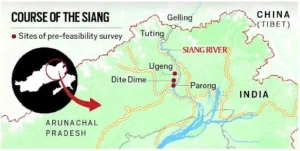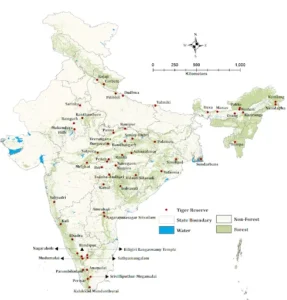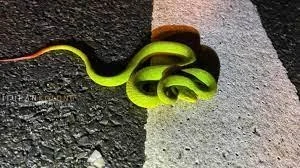UPSC GS 1
Siang
- News: Thelocals are protesting against an Upper Siang dam project in Arunachal Pradesh.
- Upper Siang Hydropower Project:
-
- The Upper Siang project is a proposed 11,000-megawatt hydropower project on the Siang River in the Upper Siang district of Arunachal Pradesh.
-
- Origin:
-
- The Siang River originates near Mount Kailash in Tibet, where it is known as the Tsangpo.
-
- Course in Tibet:
-
- The river flows eastward for over 1,000 km before forming a horseshoe bend around the towering Namcha Barwa peak.
- It forms the world’s largest and deepest canyon, the YarlungTsangpo Grand Canyon, at an altitude of more than 1,500 meters (4,900 feet).
- After the horseshoe bend, the river enters Arunachal Pradesh, India, where it is known as the Siang.
- It is called asBrahmaputrain Assam and the Jamunain Bangladesh before it empties into the Bay of Bengal.
-

- Tributaries in India:
-
- Northern Tributaries: Subansiri, Ronganadi, Dikrong, Buroi, Borgong, Jiabharali, Dhansiri (North), Puthimari, Manas, Beki, Aie, Sonkosh.
- Southern Tributaries: Noadehing, Buridehing, Desang, Dikhow, Bhogdoi, Dhansiri (South), Kopilli, Kulsi, Krishnai, Dhdhnoi, Jinjiram.
-
- Features:
-
- It is the longest river in Tibetand the fifth longest in China.
- The YarlungTsangpo River is the highest major river in the world.
- Its longest tributary in Tibet is the Nyang River.
- The Siang River serves as a lifeline for many indigenous tribes in Arunachal Pradesh and Assam, including the Adi, Memba, and Khamba tribes.
-
UPSC GS 2
Anand Marriage Act
- News: Meghalaya has implemented the Anand Marriage Act, giving statutory recognition to Sikh marriage rituals.
- Introduction:
-
- The Anand Marriage Act, passed in 1909, is a significant legal provision in India tailored specifically for the Sikh community.
-
- Historical Context:
-
- Before the enactment of this act, Sikh marriages were documented under the Hindu Marriage Act.
- The Sikh community advocated for distinct legal recognition of their marriage rituals, especially the Anand Karaj ceremony.
-
- Key Features of the Anand Marriage Act:
-
- This act legally acknowledges Sikh marriage ceremonies, known as Anand Karaj, as a legitimate form of marriage.
- The act played a crucial role in validating the unique religious and cultural identity of the Sikh community within Indian law.
- The original 1909 act did not specifically include provisions for marriage registration.
- However, subsequent amendments and legal updates have made it possible to register Sikh marriages under this act, ensuring legal clarity and security for married couples.
- The act recognizes the significance of the Anand Karaj ceremony, which is fundamental to Sikh matrimonial practices and reflects the community’s distinct religious traditions.
-
- Importance and Development:
-
- The Anand Marriage Act was a pioneering law for the Sikh community, establishing their unique religious and cultural identity within Indian matrimonial legislation.
- Over time, there have been ongoing discussions and calls for amendments to the act, aimed at providing clearer legal provisions for issues such as divorce, alimony, and the registration process
- These proposed changes seek to align the act with modern legal standards while preserving Sikh traditions.
- In 2023, the Anand Marriage Act was extended to Jammu & Kashmir, ensuring that Sikh marriages in the region are recognized and can be registered under this act.
-
Read also: Busting 5 Popular Myths About UPSC Exam
ANI’s Defamation Case Against Wikipedia
- News: Asian News International (ANI) has filed a defamation lawsuit against Wikipedia in the Delhi High Court, accusing the platform of hosting defamatory content about ANI.
- Provisions Invoked in ANI’s Defamation Case Against Wikipedia:
- Information Technology Act, 2000: ANI’s legal arguments focus on provisions of the Information Technology (IT) Act, 2000, particularly regarding intermediary liability for user-generated content.
- Definition of Intermediary:
-
- Section 2(1)(w): This section defines an “intermediary” as any entity that, on behalf of another person, receives, stores, or transmits messages or provides services related to such messages. ANI contends that Wikipedia qualifies as an intermediary under this definition.
-
- Safe Harbour Provision:
-
- Section 79: This section offers a “safe harbour” to intermediaries, protecting them from liability for third-party content if specific conditions are met.
- Section 79(1): Grants intermediaries exemption from liability for third-party content.
- Section 79(2): Specifies the conditions for this exemption, including not initiating the transmission, not selecting the receiver, and not modifying the transmitted information.
- Exceptions to Protection: Intermediaries lose protection if they fail to remove harmful content after being notified by the government or if they tamper with evidence related to such content.
-
- Intermediary Guidelines and Digital Media Ethics Code: These guidelines mandate that intermediaries:
-
- Implement a Grievance Redressal Mechanism: Establish a system for addressing complaints.
- Appoint a Grievance Officer: Designate an officer to handle complaints.
- Ensure Due Diligence: Remove or disable access to unlawful content within a specified timeframe upon receiving complaints.
-
- Relevant Supreme Court Judgements:
-
- Ayurvedic Medicine Manufacturers Organisation of India:
- October 2022: The Supreme Court dismissed petitions filed by the Ayurvedic Medicine Manufacturers Organisation of India regarding an allegedly defamatory article published in 2001.
- The court suggested that petitioners could edit the Wikipedia article and pursue other legal options.
- Hewlett Packard India Sales vs. Commissioner of Customs
- January 2023: In this case, the Supreme Court acknowledged that authorities often use Wikipedia for decision-making but cautioned that while the platform is useful for spreading knowledge, it may not always be reliable for legal matters due to its user-generated content, which can sometimes be misleading.
-
Power of Attorney (POA)
- News: The Supreme Court has observed that there would be an implied revocation of Power of Attorney granted to the agent if the act of Principal choosing to act for himself is known to an agent and third person.
- Power of Attorney (POA)
-
- A Power of Attorney (POA) is a legal authorization that grants an agent or attorney-in-fact the authority to act on behalf of an individual, known as the principal.
- This arrangement creates a principal-agent relationship where the agent acts as the principal’s representative.
-

- Scope of Authority:
-
- The agent can be granted broad or limited powers to make decisions regarding the principal’s property, finances, investments, or medical care, based on the terms specified in the POA.
-
- Activation of POA:
-
- A POA becomes effective if the principal is incapacitated due to illness or disability.
- Additionally, the agent can act on behalf of the principal if the principal is unavailable to handle financial or legal transactions.
-
- Types of Power of Attorney:
-
- Conventional (Limited) Power of Attorney: Grants specific, limited authority to the agent for certain tasks.
- Durable Power of Attorney: Remains in effect for the principal’s lifetime unless it is revoked.
- Springing Power of Attorney: Becomes effective only upon the occurrence of specified events.
- Medical Power of Attorney: Also known as a durable power of attorney for healthcare, it grants the agent authority to make medical decisions for the principal.
-
- Termination of POA: A POA ends under the following circumstances:
-
- The principal dies.
- The principal revokes the POA.
- A court invalidates the POA.
- The principal divorces a spouse who holds the POA.
- The agent is unable to continue performing the duties outlined in the POA.
-
UPSC GS 3
VeeranganaDurgavati Tiger Reserve
- News: The Madhya Pradesh government has initiated an inquiry into the alleged poaching of tigers and irregularities in the newly established VeeranganaDurgavati Tiger Reserve.
- Location: It is runs across Sagar, Damoh, and Narsinghpur districts of Madhya Pradesh.
- Area: Encompasses 2,339 square kilometers within the Nauradehi Wildlife Sanctuary and Durgavati Wildlife Sanctuary.
- Status: The seventh tiger reserve in Madhya Pradesh and the 54th in India.

- Naming: Named after Rani Durgavati, the queen of the Gondi people.
- Heritage Site: The Singorgarh Fortis located within the reserve.
- Landscape and Habitat
-
- Topography: Features a diverse landscape including hills, valleys, rivers, streams, waterfalls, and grasslands.
- Rivers: Straddles parts of the Narmada and Yamuna River basins.
- Vegetation: Predominantly dry deciduous forest.
-
- Flora: Teak, Saja, Dhaora, Ber, Amla
- Fauna:
-
- Mammals: Tigers, leopards, wolves, jackals, Indian foxes, striped hyenas, Nilgai, Chinkara, Chital, Sambhar, Black Buck, Barking deer, Common Langur, Rhesus Macaque
- Birds: Critically endangered White-Rumped and Indian Vultures.
-
- Conservation Efforts:
-
- Green Corridor: A green corridor linking Panna Tiger Reserve (PTR) with Durgavati will be developed to facilitate the natural movement of tigers to the new reserve.
-
Salazar Pit Viper
- News: A snake, named after Harry Potter character Salazar Slytherin, was found in Assam’s Kaziranga National Park.
- What are Pit Vipers?
- Definition:
-
- Pit vipers are a subfamily of venomous snakes that possess a heat-sensitive pit organ located between each eye and nostril, in addition to two movable fangs.
-
- Heat-Sensing Ability:
-
- The pit organallows them to detect infrared thermal radiation (heat) emitted by their prey, enabling them to hunt effectively in the dark.
-
- Habitat:
-
- Found in diverse habitats, including deserts, forests, grasslands, and wetlands.
-
- Adaptability:
-
- They can be terrestrial, arboreal, or aquatic.
-
- Distribution
-
- Present on every continent except Antarctica.
- Most species are found in tropical and subtropical regions, with some species also inhabiting temperate regions.
- A significant number of species are located in Asia and the Americas.
-
- Reproduction
-
- Egg-Laying and Live Birth: Some species lay eggs, while others give birth to live young.
-

- Key Facts about Salazar Pit Viper
-
- Discovery: First identified in Arunachal Pradesh, India, in 2019.
- Distinctive Markings: Males exhibit a unique orange-to-reddish stripe on the head and body.
- Scientific Name:Trimeresurussalazar.
- Characteristics
- Description: Charismatic venomous snakes with a wide range of morphological and ecological diversity.
- Distribution: Found across East and Southeast Asia, with at least 48 known species. At least 15 species occur in India.
- Coloration: Typically green, but some species feature yellow, black, orange, red, or gold markings.
- Diet: Prey on various animals, including lizards, amphibians, birds, rodents, and other small mammals.
- Cryptic Nature: Morphologically cryptic, making field identification challenging.
-
Equity Mutual Funds
- News:Inflows into equity mutual funds surged by 17 percent to Rs 40,608.19 crore in June, a fresh high according to the latest data released by the Association of Mutual Funds of India.
- Overview
-
- Equity Mutual Funds are a type of investment fund that pools money from investors to trade primarily in a portfolio of stocks, also known as equity securities.
- They are also known as Growth Funds.
-
- Types of Equity Funds:
-
- Active Funds: In an Active Fund, a fund manager actively scans the market, conducts research on companies, examines performance, and selects the best stocks to invest in.
- Passive Funds: In a Passive Fund, the fund manager builds a portfolio that mirrors a popular market index, such as the Sensex or Nifty Fifty. The fund manager’s role is passive, as buy, hold, or sell decisions are driven by the benchmark index, with the fund manager replicating the index with minimal tracking error.
-

- Classification by Market Capitalisation: Equity Funds can be classified based on Market Capitalisation, which refers to how much the capital market values an entire company’s equity. The classifications include:
-
- Large Cap Funds
- Mid Cap Funds
- Small Cap or Micro Cap Funds
- Classification by Investment Approach
- Diversified Funds
- These schemes invest in stocks across the entire market spectrum, providing broad market exposure.
-
- Sectoral / Thematic Funds:
-
- These schemes are restricted to only a particular sector or theme, such as Infotech or Infrastructure, focusing on specific industries or investment themes.
-
Denisovans
- News: Scientist have revealed mysterious Denisovans humans species used to live160,000 years ago on Tibetan plateau.
- Archaeological Site:
-
- The exact location of this cave is said to be near the city of Xiahe in China’s Gansu province.
-
- Denisovans:
-
- Denisovans are an extinct species of hominids closely related to modern humans.
- They are a relatively recent addition to the human family tree, with the first Denisovan remains discovered in a Siberian cave in 2010.
-

- Geographic Range and Habitat:
-
- Denisovans inhabited a diverse range of environments, from the cold mountains of Siberia and Tibet to the jungles of Southeast Asia, during the last Ice Age.
-
- Time Period:
-
- Denisovans lived approximately from 500,000 to 30,000 years ago.
-
- Genetic Relationships:
-
- DNA evidence indicates that Denisovans are related to both Neanderthals and modern humans.
- They likely interbred with both species.
- Denisovans share a common ancestor with modern humans and Neanderthals, known as Homo heidelbergensis, which likely lived in Africa.
-
- Physical Characteristics:
-
- Denisovans may have had dark skin, dark hair, and dark eyes.
-
- Population Size:
-
- The Denisovan genome shows low genetic diversity, suggesting that their population may have always been relatively small.
-
- Neanderthals:
-
- They are human’s closest extinct human relative.
- Some defining features of their skulls include the large middle part of the face, angled cheek bones, and a huge nose for humidifying and warming cold, dry air.
- Their bodies were shorter and stockier than ours, another adaptation to living in cold environments. But their brains were just as large as ours and often larger – proportional to their brawnier bodies.
-
CAMCOPTER S-100
- News: Ahead of Prime Minister Narendra Modi visit to Austria, Indian Navy is currently getting to exploit and utilise CAMCOPTER S-100 rotary unmanned aerial system in the Indian Ocean Region.
- About:
-
- The CAMCOPTER S-100 is an unmanned aerial vehicle (UAV) from Austria, designed as a rotorcraft.
- Developed by Schiebel, an Austrian company, it was produced between 2003 and 2005.
-
- Features:
-
- Maximum take-off weight: 200 kg
- Powered by a heavy fuel engine
- Can operate continuously for 6 hours
- Maximum speed: 220 km/hr
- Maximum altitude: 5,500 meters
- Can carry multiple payloads, both for surveillance and tactical purposes, with a maximum payload weight of 50 kg
- Requires no prepared area or special launch/recovery equipment
- Operates day and night in adverse weather conditions
- Navigates automatically using pre-programmed GPS waypoints or can be controlled directly with a pilot control unit
- Missions are planned and managed through a simple point-and-click graphical user interface
- Transmits high-definition payload imagery to the control station in real-time
- Uses “fly-by-wire” technology controlled by redundant flight computers, allowing it to complete missions automatically even in complex electromagnetic environments
-
10 CubeSat Radio Interferometry Experiment (CURIE)
- News: NASA is preparing to launch the CubeSat Radio Interferometry Experiment (CURIE) mission to explore the origins of solar radio waves.
- About CURIE:
-
- CURIE employs a pioneering technique known as low-frequency radio interferometry, marking its debut in space applications.
- The mission comprises two miniature spacecrafts, each no larger than a shoebox, which will orbit Earth approximately two miles apart.
- This separation allows the instruments to detect subtle differences in the arrival times of radio waves, enabling precise identification of their solar source.
-

- Working Mechanism:
-
- Frequency Range: CURIE will measure radio waves in the 0.1 to 19 megahertz range, frequencies that are blocked by Earth’s upper atmosphere and thus require space-based observations.
- Orbit: The spacecraft will orbit 360 miles above Earth’s surface to achieve an unobstructed view of the Sun’s radio emissions.
- Deployment: Once in orbit, the two CURIE spacecraft will separate, deploy their eight-foot antennas, and commence data collection.
-
- Significance:
-
- This mission aims to enhance our understanding of solar phenomena and set the stage for future space-based radio astronomy projects.
-
- Sponsorship
-
- CURIE is sponsored by NASA’s Heliophysics Flight Opportunities for Research and Technology (H-FORT) Program.
-

